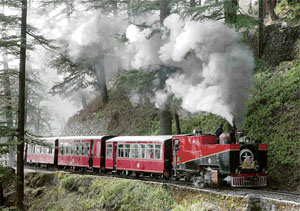|
A historic track record
Ambika Sharma on the Kalka-Shimla rail line which is tipped for inclusion in the world heritage list
|

The 96-km Kalka-Shimla track goes through 102 tunnels. —
Photo by Malkiat Singh
|
The
104-year-old
historic Kalka-Shimla railway track may well be on its way to
being included in the coveted world heritage list. A
seven-member UNESCO team would be inspecting it on September 11.
This would add another feather to its cap. It is already
enlisted in ‘Rail Facts and Feats’ in The Guinness Book
of World Records as the greatest narrow gauge engineering
feat of the mechanical age.
Constructed in the
early 20th century, it is an engineering feat and among the
country’s four unique narrow-gauge rail tracks. This railway
line was first sketched in November 1847, almost 50 years before
its construction. It was inaugurated by the British Viceroy,
Lord Curzon, in November 1903.
Covering a
distance of 96 km from Kalka, the track meanders through deep
ravines and the lofty Shivalik hills. Being a narrow-gauge rail
line, mini-trains, popularly called ‘toy trains’, run on
these tracks. A traveller is taken in by the unblemished natural
setting and a memorable journey that wades through 102 tunnels,
big and small. Initially, there were 103 tunnels, but tunnel
number 46 does not exist any more. A toy train takes about three
minutes to cross the longest tunnel at Barog. The other three
big tunnels en route are at Koti (2,276 ft), Taradevi (1,615 ft)
and tunnel no. 103 (1,135 ft).
The journey from
Kalka at 640 m above sea level, almost immediately leads to a
hilly panorama till it reaches the dizzying heights of Shimla at
2,060 m. The toy train gradually traverses hills, bridges and
brooks, refreshing the traveller with nature’s vast treasures
of green pines, alpines, deodars, oak and maples. At the
foothills one gets an awe-inspiring view of the Kaushalya river
and the tiny stations on the way like Koti, Barog and Kanoh that
are characterised by neat gardens and gabled roofs.
The Kalka-Shimla
toy train has about seven coaches that can accommodate as many
as 200 passengers in a single trip. The trains have an arduous
task in trying to negotiate the ascend of more than 2,000 m and
it’s the pertinently devised 700 horsepower B-B type diesel
engine which has been braving the steep climbs for decades now.
Braving temperature ranging from 0`B0C to 45`B0C, snowfall as
well as an annual rainfall of 200-220 cm, the toy trains move at
an average speed of 25-30 km.
It was during the
British regime that the idea to lay this track was conceived.
After spending the summer in Shimla in 1827, Lord Amherst, the
Governor-General of India, caught a fancy for the town. It was
during his successor Lord William Bentinck’s term that Shimla
became the summer headquarters of the government.
The journey from
the plains to Shimla was considered arduous and tough. The first
major achievement in this direction was the opening of the Grand
Hindostan and Tibet Road in 1856. Earlier, the mode of travel to
the hills was by jampans (sedan chair fitted with curtains and
slung on poles borne by bearers at an even trot) for women, and
men usually rode the track via Kasauli, Kakkarhati, Haripur and
Syree to Shimla. Then came the 58-mile tract to Shimla passing
through Dharampur, Solan and Kairee Ghat, to be followed by the
Kalka-Shimla Tonga Service.
It was during the
tenure of Marquess of Dufferin as the Viceroy (1884-1888) that
the construction of a railway line was actively considered. A
new company, Delhi-Umbala-Kalka Railway, started the
construction of the line from Ambala to Kalka in 1891. It took
another 10 years to extend this line to Shimla when Lord Curzon
was the Viceroy, and the line was formally opened on November 9,
1903, after having spent Rs 1.6 crore, with a single track of
2ft-6in gauge.
Connecting Kalka
to Shimla was no easy task as the civil engineers had to lay the
track so that it did not disturb the pristine surroundings.
Chronicled as the most surveyed project of its time, it was a
correspondent of Delhi Gazette who first sketched the
route in 1847. No work was done on the project till 1885, when
the project was revived again. Even a second report, prepared
for this rail link in 1887, failed to initiate any concrete
work. Yet another survey, commissioned in 1895, finally resulted
in the signing of the Kalka-Shimla Construction Contract. Baba
Bhalku, a local, proved of much assistance in laying this track
whenever the British engineers encountered a problem.

|